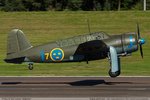And the Mk 2 had a speed under 230 mph. Even at 251, it wan't dropping the torpedo at that speed. The torpedo issue has NOTHING to do with the aircraft.
Performance
Maximum speed: 228 mph (198 kn, 367 km/h) at 1,750 ft (533 m)
The Mk 1 had a 1300hp Merlin 30 engine, and the Mk II had a 1640 hp Merlin 32. I really question the wikipedia stats for the Mk2, especially the speed, as they aren't referenced to flight tests, and I wonder if these speeds are with the engine at the 5min combat rating?

